PDF-Flow in Gutters & Downpipes Gwilym T. Still University of Warwick Apri
Author : stefany-barnette | Published Date : 2016-05-29
1 Abstract This project deals with the development and empirical testing of a spatially varying flow model for analysis of rainwater flow in gutters This area is
Presentation Embed Code
Download Presentation
Download Presentation The PPT/PDF document "Flow in Gutters & Downpipes Gwilym T. St..." is the property of its rightful owner. Permission is granted to download and print the materials on this website for personal, non-commercial use only, and to display it on your personal computer provided you do not modify the materials and that you retain all copyright notices contained in the materials. By downloading content from our website, you accept the terms of this agreement.
Flow in Gutters & Downpipes Gwilym T. Still University of Warwick Apri: Transcript
Download Rules Of Document
"Flow in Gutters & Downpipes Gwilym T. Still University of Warwick Apri"The content belongs to its owner. You may download and print it for personal use, without modification, and keep all copyright notices. By downloading, you agree to these terms.
Related Documents














